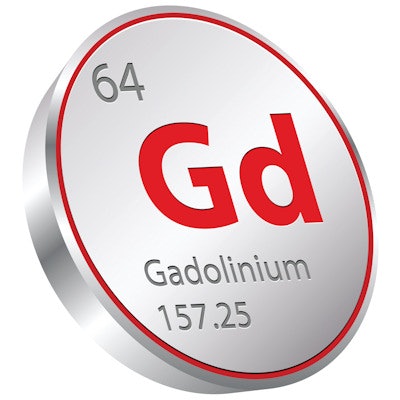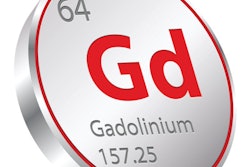
As radiologists and clinicians maintain their vigilance over the judicious use of gadolinium-based contrast agents (GBCAs) for MRI scans, a new prospective study in Radiology has found that one agent, gadobutrol, resulted in a very low number of allergic-like reactions.
Researchers at Princess Margaret Cancer Centre in Toronto tallied only 96 adverse events from more than 30,000 gadobutrol-enhanced MRI scans over a four-year period. Of that total, only three cases were deemed moderate allergic reactions, and there was only one case of a severe reaction to the contrast agent.
"Our allergic reaction rate was 0.32% overall," said lead author Sarah Power, PhD, a radiology fellow at the facility at the time of the study. "That is a little bit higher than some of the [previous] retrospective studies, but those studies were retrospective. I don't think they would have identified properly all reactions, because people might not report mild reactions."
Gadobutrol's history
Gadobutrol, which is marketed by Bayer HealthCare as Gadavist, initially received U.S. Food and Drug Administration (FDA) clearance in March 2011 for contrast-enhanced MRI scans of the central nervous system. In June 2014, the FDA expanded gadobutrol's use for breast MRI to assess the presence and extent of malignant breast disease. In January 2015, the agency approved the agent for MRI in pediatric patients younger than 2 years old.
Previous studies have shown that gadobutrol, a macrocyclic GBCA, is associated with a lower incidence of nephrogenic systemic fibrosis (NSF), a potentially debilitating disease that has been associated with patients with insufficient renal function. Despite the positive reviews for gadobutrol and NSF, an overall allergic reaction rate for the GBCA is not well-known.
The relatively recent regulatory clearances for gadobutrol are the primary reason why previous research into potential allergic reactions is lacking, Power surmised.
"It was only approved for use in the U.S. in 2011 and in Canada since 2004," added Power, who currently serves as an interventional diagnostic neuroradiologist at Beaumont Hospital in Dublin. "When we realized that, we thought [the study] was something that would certainly be of interest to the radiology community overall."
GBCA-enhanced MRI
The prospective study looked at patients who received gadobutrol at Princess Margaret Cancer Centre, one of five hospitals within the University Health Network, between January 2011 and December 2013. During that time, the facility performed 30,373 gadobutrol-enhanced MRI scans on 19,074 patients (Radiology, October 2016, Vol. 281:1, pp. 72-77).
"We started collecting data prospectively on patients who were having allergic-like reactions as part of a quality assurance initiative to confirm its safety in clinical use," Power told AuntMinnie.com. "We realized some patients were having allergic reactions to gadolinium agents."
Out of all gadobutrol-based MRI scans, there were 96 allergic-like reactions over the four-year study period, for an adverse event rate of 0.32% among 82 patients. On a per-patient basis, the allergic-like reaction rate was 0.43%.
| GBCA use at Princess Margaret Cancer Centre | |||
| Contrast agent | Injections | Patients | Reactions |
| Gadobutrol | 30,373 (92%) | 19,074 | 96 |
| Gadopentetic acid | 1,535 (5%) | 1,405 | 0 |
| Gadoxetate disodium | 1,058 (3%) | 918 | 5 |
| Gadofosveset trisodium | 15 (0.5%) | 15 | 1 |
| Unknown | 10 (0.5%) | 9 | 0 |
Of the 96 adverse reactions to gadobutrol, 92 (96%) were deemed mild, followed by three (3%) moderate reactions and one (1%) severe reaction. The four moderate and severe reactions all involved women.
Among the mild reactions, 47 patients (51%) needed only observation, while 44 (48%) required oral antihistamine therapy and one (1%) was treated orally with prednisone.
The one severe reaction involved a patient who had difficulty breathing and swallowing within eight minutes of the injection, and it took 50 minutes of resuscitation to stabilize her. She was transferred to the intensive care unit but was later discharged with no permanent adverse aftereffects.
Delayed reactions
Of particular note is the number of delayed adverse reactions, which involved 15 gadobutrol-enhanced MRI scans (16%), for a rate of 0.05%. The researchers defined an adverse gadolinium reaction as delayed if the event occurred at least 30 minutes after the injection.
The most common type of delayed reaction was urticaria, also known as hives or a skin rash. All of the observed delayed reactions were mild.
"We have always advised our patients about the potential of a delayed reaction." Power said. "Very few papers report prospective numbers including delayed reactions that are only allergic-like reactions."
2nd experiences
Power and colleagues also noted that 28 patients (34% of the total number of adverse reactions) had an allergic reaction to gadobutrol after previously receiving gadolinium and reporting no prior adverse reaction.
"So, it is important for us to remain vigilant about these patients and for all gadolinium agents," she said.
When asked about the potential long-term effects from GBCAs, given previous studies that found traces of gadolinium in the brain tissue of deceased patients long after they received the contrast agent, Power said that they jury is still out on the topic.
"I don't think we have that information yet on whether there is a difference between linear or macrocyclic gadolinium agents that show up later in brain tissue or the skin," she said. "I would suspect that the gadolinium agent that is less likely to show up later is the one that clinicians would prefer to use."


.fFmgij6Hin.png?auto=compress%2Cformat&fit=crop&h=100&q=70&w=100)





.fFmgij6Hin.png?auto=compress%2Cformat&fit=crop&h=167&q=70&w=250)











